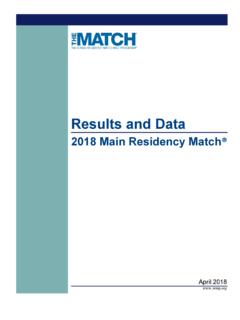Transcription of Medicaid Prospective Payment Update - …
1 Medicaid Prospective Payment Update Tom Parker Lorne Simmons Director of Healthcare Manager Reimbursement Florida Moore Stephens Lovelace CPA's Heath Care Association & Advisors 1. Presentation Outline I. Where We Have Been II. Where We Are III. Where We Are Going IV. Resources V. Questions Where We Have Been Current Reimbursement Methodology was developed in the 1980's Gainesville Plan over the course of a couple of years Provider Specific and cost report based Subject to Audit 1. Current System - Costs Cost Components Operating: Administrative, Housekeeping, Liability Insurance, Laundry, Plant Operations, Utilities Patient Care: Split into indirect and direct care in 2002.
2 Direct Care: RN, LPN, CNA. Indirect Care: Activities, Dietary, Social Work, Med Recs, Nsg Admin, Supplies, Therapy (allocated & limited). Property: Cost Based or Fair Rental Value (FRV). Overwhelming Majority paid on the FRV model Current System- Rates Prospective Rates with Retrospective Adjustment/Settlement Until 2015 rates were set twice a year, January 1 and July 1. Effective September 1, 2015 switched to an annual rate setting Per Diem costs are calculated and inflation adjusted Rate Limitations Operating Cost based and target class ceilings Provider specific and new provider target limits Direct Cost based and target class ceilings Indirect Cost based and target class ceilings Provider specific and new provider target limits Property FRVS and Statewide ceilings Nursing Facility Quality Assessment Created in 2009 during state budget shortfalls s.
3 Allows nursing facilities to contribute money to AHCA that is used to draw down federal matching funds and return to providers Quality assessment matching funds are used to enhance rates through 3 parts currently Medicaid Share Return Operating Add-on Restore rate reductions effective on or after January 1, 2008. For state fiscal year 2016-17 providers contribute $419 million and receive that plus an additional $632 million in federal matching funds 2. Where We Are Going Medicaid Transitioned to Managed Care in 2013. Complications surrounding rate adjustments for managed care companies Hospital Inpatient (DRG) and Hospital Outpatient (EAPG).
4 Have already transitioned Funding a study to transition nursing facilities has been discussed each of the last few years SPECIFIC APPROPRIATION 186 OF. THE 2016 GENERAL APPROPRIATIONS. From the funds in Specific Appropriation 186, $500,000 in ACTnonrecurring funds from the Medical Care Trust Fund is provided to the Agency for Health Care Administration to contract with an independent consultant to develop a plan, collaboratively with all interested stakeholders, to convert Medicaid payments for nursing home services from a cost based reimbursement methodology to a Prospective Payment system.
5 The study should recommend a Payment system that promotes quality, ensures access, and reflects simplicity and equity. The study should outline steps for a phase in process to ensure providers have time to adjust to Payment changes. The study shall identify steps necessary for the transition to be completed in a budget neutral manner. Additionally, the report shall address the impact of a Prospective Payment system on Medicaid reimbursement rates for Hospice providers. The report shall be submitted to the Governor, the President of the Senate, and the Speaker of the House of Representatives no later than January 1, 2017.
6 AHCA Study Guidelines Independent Consultant Hired Navigant Consulting who helped the state with developing hospital inpatient and outpatient reimbursement systems Work collaboratively with all interested stakeholders They have already met with several group and will continue to do so during the process Also holding public hearings- August 18, September 22, and October 20. Prospective Payment System Need to eliminate the retroactive rate adjustments that are currently causing problems for everyone involved 3. AHCA Study Guidelines Quality, Access, Simplicity, and Equity Guiding Principles Phase in process Gives providers time to adjust their business model to a different revenue stream Budget Neutrality Elephant in the room during every conversation Due date January 1, 2017.
7 Report shall be given to the Governor, President of the Senate, and Speaker of the House of Representatives Guiding Principles Quality Does the methodology promote and reward high quality long-term care provision? Access Does the methodology promote and maintain access to care for people who require long-term care, including hard to serve patient populations? Equity Does the methodology promote equity in Payment across providers for care and properly address various cost centers? Predictability Does the methodology improve the ability for AHCA and providers to adequately plan and budget?
8 Simplicity Is the methodology easy to understand and replicate? FHCA Task Force FHCA has formed a task force chaired by Deborah Franklin which is working collaboratively with AHCA on the PPS. The goal is to gain broad consensus before presenting recommendations to AHCA. Some areas where work is being done include, quality metrics related to payments and an updated Fair Rental Value model Has representatives appointed by FHCA President, Joe Mitchell, from the Reimbursement Committee and the Quality Council Has held several meetings already and met with Navigant multiple times 4.
9 Why Fair Rental Value? A well designed Fair Rental Value system will Differentiate reimbursement based upon age/condition/size Provide incentives to generate capital resources for renovation, improvement, and replacement Impact the physical environment that can result in improvement of residents quality of life Fair Rental Approaches Gross Fair Rental Net Fair Rental Hybrid Fair Rental Value Changes Updating the current model that is 30+ years old Adding incentive for providers to renovate existing buildings and receive appropriate reimbursement and return on their investment Working with national health care consultant Joe Lubarsky of Eljay LLC, who has done FRV work in other states including Georgia, Mississippi, Washington.
10 Virginia, Tennessee, among others FHCA worked with AHCA to collect facility renovation/replacement data that will potentially be used in designing a new system Hope to have a plan approved to share with AHCA/Navigant at the meeting next week Quality Measures Secretary Dudek stated that She cannot support a system in which Payment is not tied to quality . The Task Force has spent several meetings discussing how to measure quality and the Payment incentives/disincentives to tie to it Have reviewed what several other states are doing Working with Dr.







